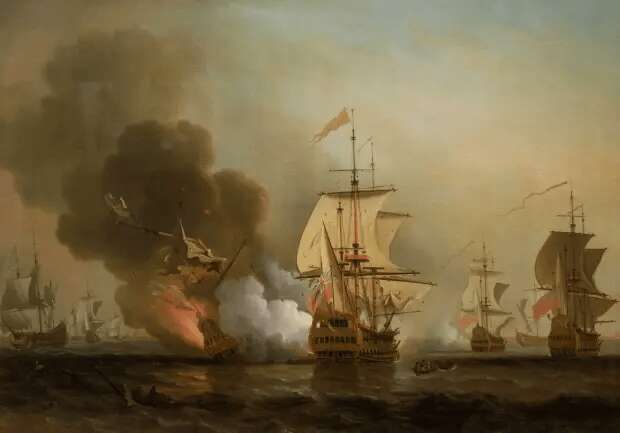THE MOTHER of all shipwrecks is finally set to be salvaged, with recovery teams starting the removal of artefacts in April.
The Spanish San Jose Galleon sank off the Colombian port of Cartagena in 1708, where it rested, unknown, until 2015.




Its discovery has been fraught with long-standing legal disputes regarding ownership.
Spain, Colombia, Bolivian indigenous groups, and even the US have all been claiming that the wreck, and its $16billion treasure, belong to them.
Now, almost a decade after the discovery, the Colombian government has announced that they will finally be putting these tensions to one side.
 Lucas Perez pays part of own transfer fee to rejoin beloved Deportivo
Lucas Perez pays part of own transfer fee to rejoin beloved Deportivo
Alhena Caicedo, the director of the Colombian Institute of Anthropology and History, revealed that the work could begin as early as April.
Caicedo added: “There has been this persistent view of the galleon as a treasure trove. We want to turn the page on that.
“We aren’t thinking about treasure. We’re thinking about how to access the historical and archaeological information at the site.”
Caicedo, amongst other historians, believe that the galleon could offer currently unknown information about the Spanish empire at its peak - and its involvement in Latin America.
Caicedo says she hopes her team will eventually be able to bring the shipwreck out of the sea and put it on display in a museum.
“This is a huge challenge and it is not a project that has a lot of precedents. In a way, we are pioneers,” Caicedo said.
Very few ships have ever been salvaged after being fully submerged, and none have ever been recovered from tropical waters.
Caicedo added: “The contents are really varied and we have no idea how the remains will react when they come into contact with oxygen.
"We don’t even know if it is possible to raise something out of the water."
Earlier this month, Colombia's Culture Minister Juan David Correa revealed that an underwater robot will be sent to extract items surrounding the ship to see "how they materialise when they come out".
 What is Balenciaga and how do you pronounce it?
What is Balenciaga and how do you pronounce it?
The project is expected to cost the government more than $4.5 million, in the hope that it will help experts to understand how they can recover the remainder of the wreck.
It is set to be the biggest, most costly, and most complex recovery mission completed underwater.
The state-of-the-art robot will work at a depth of 600m to extract materials "without modifying or damaging the wreck," according to Correa.
Although the robotic equipment will be submerged, it will be connected to a Navy ship that will use cameras to keep an extensive record of every movement.
Navy researcher Captain Alexandra Chadid explained that, after three centuries of being submerged in the sea, most of the treasure has undergone physical and chemical changes.
The primary objective of the mission, therefore, is to determine how to stop the items from disintegrating when it is pulled out of the water.
Back in 2017, the Colombian Navy sent a remotely operated vehicle to a depth of 3,100ft to assess the wreckage and give a glimpse into what was sitting onboard.
Incredible images showed gold pieces, cannons and perfectly preserved Chinese porcelain cups scattered across the San Jose.
Trinkets were seen twinkling under the light of the cameras as bronze cannons, swords, and clay vessels were spotted on the seafloor.
Historians dubbed it the "holy grail" because it was carrying one of the largest amounts of treasure ever lost at sea.
The expedition to recover the fortune would start between April and May, depending on weather conditions.
But the discovery of the legendary galleon was met with intense legal claims over ownership.
Spain has insisted that the sunken treasures belong to them - given that it was a Spanish ship.
While Bolivia's indigenous Qhara Qhara nation have said that they were forced to mine the treasures for the Spaniards, and so it rightfully belongs to them.
The American research firm Glocca Morra, now called Sea Search Armada, claims they found the San Jose in 1981 and had given the coordinates to the Colombians for half the bounty.
This was denied by former Colombian president Juan Manuel Santos, who asserted that the Navy had found the vessel at a different location.
Colombia now considers the San Jose as part of its cultural heritage and as it was found in their territorial waters by them.
And Colombia's current president, leftist Gustavo Petro, has adopted the same line.
He has desperately been scrambling to use the country's own resources to recover the wreck, ensuring that it remains in Colombia.
For Petro, the wreck's importance supercedes the treasure, and he hopes that countries won't fight for it as if they were still in colonial times.
It is thought that Joaquin de Aristegui, Spain's ambassador to Colombia, will offer Petro a bilateral agreement to protect the wreck.
Bolivia has also expressed their willingness to work with Petro's government - they are just asking for a few pieces from the ship.
Native leader Samuel Flores said: "Not only for the symbolic issue but more for the spiritual issue.
"We just want our ancestors to be at peace."
Meanwhile, Sea Search Armada is suing for half the treasures - estimated at an eye-watering $10 billion.
The actual location of the wreck remains unknown, but is believed to be just off the coast of Colombia, in the Caribbean Sea.
Only the Colombian government knows it's exact coordinates.




